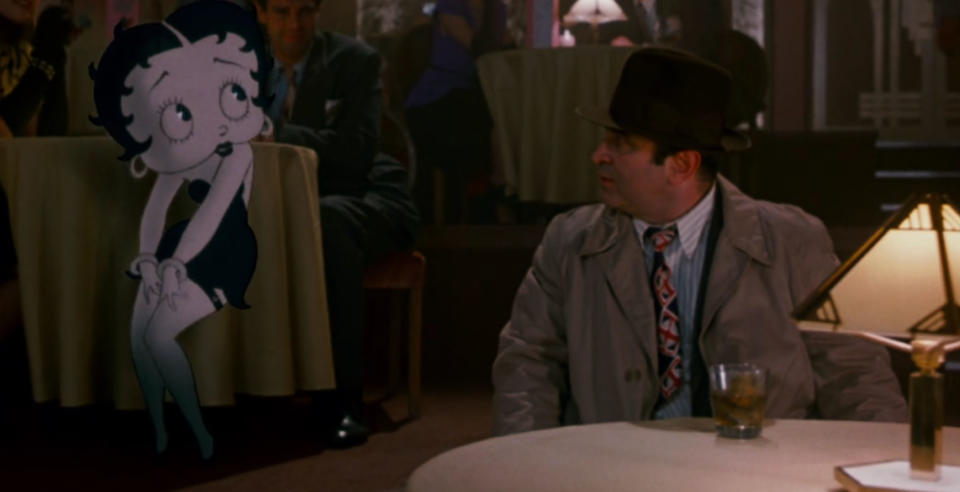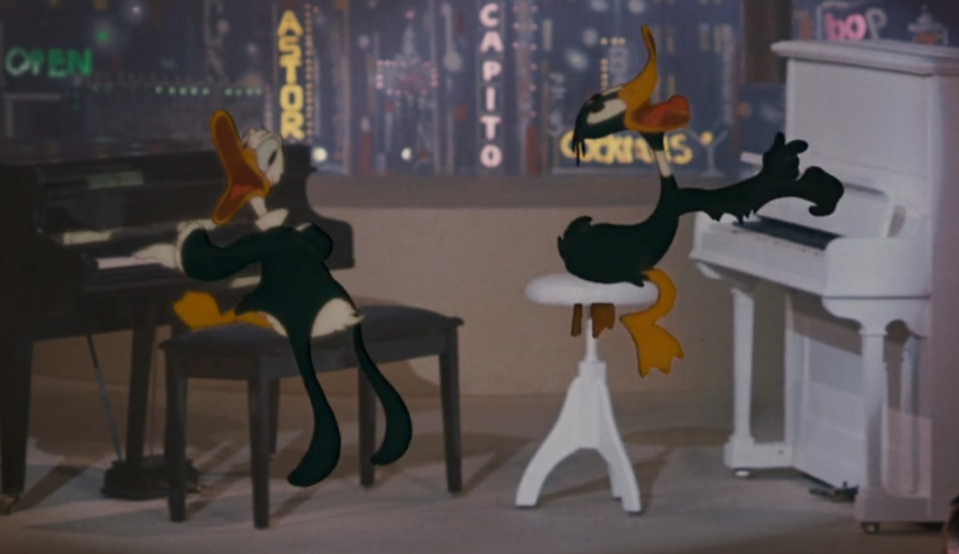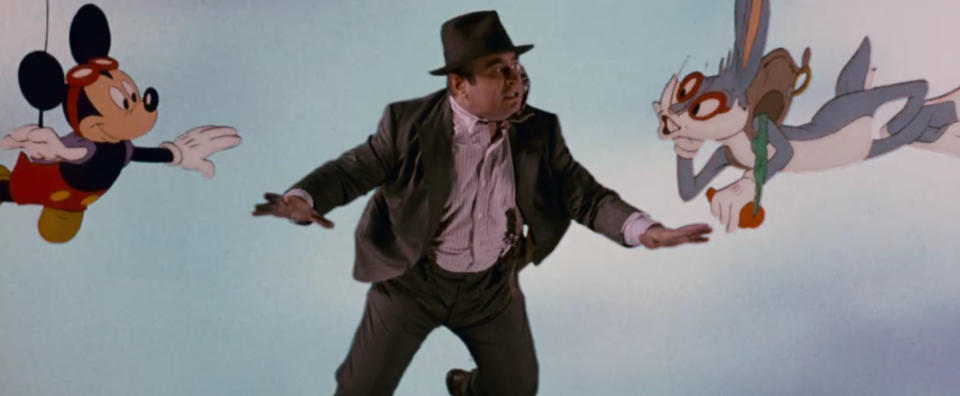'Who Framed Roger Rabbit' turns 30: How the toon-powered classic revolutionized Hollywood
Thirty years ago, Robert Zemeckis invited moviegoers to enter a version of 1940s Hollywood where humans and animated toons lived side by side. Released on June 22, 1988, the Disney-produced Who Framed Roger Rabbit was an immediate sensation and remains a mind-blowing visual marvel today. Although past Mouse House movies like Mary Poppins and Bedknobs and Broomsticks had allowed live-action and animated characters to exist in the same frame for portions of the movie, Who Framed Roger Rabbit had to expand that feat to fit a feature-length runtime. Doing that required Zemeckis and his crew — including animation supervisor Richard Williams — to pioneer animation and compositing techniques that are still employed today.
If you’re trying to single out a scene that best encapsulates the movie’s magic, look no further than the Ink and Paint Club sequence where private eye Eddie Valiant (Bob Hoskins) pays a visit to a well-known toon watering hole while doing reconnaissance for the studio that employs superstar cartoon bunny Roger Rabbit (voiced by Charles Fleischer). “That was where the rubber meets the road,” Roger Rabbit scribe Peter Seaman told Yahoo Entertainment when we spoke with him and co-writer, Jeffrey Price. “If that [scene] didn’t work, the whole thing wasn’t gonna work. It was very, very complicated to shoot.” (Watch our interview with Seaman and Price, above.)
According to the screenwriters, Zemeckis always had a grand vision for the Ink and Paint Club as a place where multiple cartoon characters — each of whom had its own bit of funny business — would fill the frame. A cursory glance around the nightclub reveals penguin waiters, an octopus bartender, and a vintage black-and-white cartoon heroine slinging drinks. “Bob wanted one of those almost Scorsese-like reveals, where you track in and all the stuff is happening,” Seaman remembers. “We did write gags for like the bartenders — he’s got eight arms, and he’s making these different cocktails. We’d write gags for the penguins, and everybody in there.”

They also wrote Golden Age cartoon pinup Betty Boop into the scene before they knew whether or not they would get permission to use her. Because Roger Rabbit was being produced at Disney, the writers had access to the studio’s library of characters and, thanks to an unprecedented arrangement with Warner Bros. — brokered by none other than executive producer Steven Spielberg — the Looney Tunes catalogue was open to them as well. But the rights to Betty had passed through multiple hands over the years, requiring a separate deal. “We wrote that scene for Betty, and if she were lost to us, we would have slotted somebody else in or just written a new scene,” Seaman says, explaining how they handled cases where certain classic characters were taken off the table. “They weren’t shy about having us rewrite stuff, that’s for sure! The cool thing is, because we shot the live action first, there was another two-and-a-half years to rewrite the movie. You were a little bit locked in to what the action was, but you could put any toon you wanted and have them say whatever you wanted.”

One moment that didn’t require any rewrites was the face-off between Daffy Duck and Donald Duck, who are engaged in an epic piano battle when Eddie enters the Ink and Paint Club. “I don’t think people really appreciated at the time how historic that was,” Seaman says of uniting these two icons of animated duck kind. Adds Price: “People thought, ‘Wait a minute, weren’t they ever in a picture before together? Don’t they work for the same studio?’ They didn’t! That was an amazing thing never to happen again.” The writers credit Zemeckis with hitting upon the idea of a piano war, while Williams’s animation team deliberately drew Daffy in his earlier, loonier phase as opposed to the more refined (if still explosive) fowl he became later on. “They mellowed him out over the years,” Price says of Daffy’s evolution. “They made him suave. Originally, he was psychotic, like somebody who escaped from the asylum.”

Maybe the other reason why moviegoers don’t fully appreciate the historic nature of Daffy and Donald’s squabble is that both they — and everyone else in the scene — are overshadowed by the arrival of Jessica Rabbit. From the moment that Roger’s beloved bride (voiced by Kathleen Turner) extends her shapely leg through the nightclub’s curtain, all eyes are on her perfectly drawn face and form. “Roger is sick about thinking that his wife is having an affair, and you think, ‘Well, it’s Jessica Rabbit and he’s Roger Rabbit, so he’s married to a rabbit,'” Price says. “So when the curtain parts, all of a sudden this hyper-sexualized cartoon character comes out! That was the big reveals, that she’s a femme fatale, not some silly character.” It’s the unexpected capper to a scene that’s already filled with surprises. “We wrote that sequence to be as crazy as it could be,” notes Seaman. “Everything [else] goes away when Jessica comes out. That’s what makes it, you know?”
As the writers remember, they and Zemeckis were kept in a state of suspense as Williams perfected Jessica’s design. “Bob Zemeckis would say, ‘Hey Richard, I need to see what Jessica looks like,'” Price says. “And he would say, ‘Well, I’m not ready to show her to you yet.’ Everyone was kind of concerned about whether he was gonna come up with this. Then he did! He spent a lot of time working on the mechanics of Jessica’s body and how her hips swayed and counterpoints the way her bosoms swayed. That whole thing of her taking [Eddie’s] necktie and pulling him closer — people went nuts when they saw that, because it was pretty sexy for a cartoon.”

Seaman says that Jessica’s appearance inspired them to add new jokes to the film that were definitely not standard Disney fare. “There’s a scene where she visits Eddie in his office, and he stands up and bumps his head on her breasts. That’s not something you normally see in a Disney movie! We had a friend who called up and said, ‘Hey, well done. My son just went through puberty watching your movie.'”
Here are other secrets that Price and Seaman shared with us about the making of Who Framed Roger Rabbit, including who the villain was before Judge Doom, and whether there’ll ever be a sequel.
Baby Herman saved their bacon
When Disney snapped up the rights to Gary K. Wolf’s novel Who Censored Roger Rabbit? in the early ’80s, Price and Sherman were the first writers they hired to transform the cult book — which was strikingly different in narrative and tone — into a potential blockbuster. One of the earliest creative decisions they made was to open the film with a cartoon that illustrates Roger’s star power, as well as his collaboration with the character they most enjoyed writing, cigar-chomping troublemaker Baby Herman. “We thought, ‘How is the audience going to appreciate the fact that Roger is this famous guy?'” Price says. “So we decided that the movie would open with a cartoon, and that stayed from the very first draft all the way until the movie you saw.” Over the course of Roger Rabbit‘s multiyear journey to the screen, the project fell into the hands of other writers, and it was Zemeckis who brought the original team back when he officially came aboard as the director. “He remembered that cartoon, and several of the newer drafts hadn’t included it. So he said, ‘Find the guys who wrote that draft,’ and that’s how we were brought back on it!”
DeGreasy before Doom
Although Roger, Jessica, and Eddie all originated in the pages of Wolf’s novel, the film’s nightmarish villain, Judge Doom (played by Christopher Lloyd), was entirely the invention of the screenwriters. In their earliest drafts, Price and Seaman did hew closer to the book, designating Rocco DeGreasy — a cartoon syndicate magnate whose murder kicks off the plot of the book — as the heavy. But as the focus of their story changed from a simple “whodunit” to a larger mystery that touches on the history of Los Angeles itself, the duo realized the story required a more threatening foe. “We needed someone to represent what was ultimately going to be the conspiracy of the movie, and not the red herring of Roger being a murderer,” Price says. “We decided that it would be revealed that he was not a human being, but was just posing as someone who hated toons and was very draconian in his treatment of them.” Seaman remembers scripting one of the scariest moments in the film — when Doom drops his human fa?ade and reveals himself to be a toon. “We call it the ‘Oh f*** moment,'” he says, laughing. “That was a big breakthrough for us.”

Taking the plunge with Mickey and Bugs
Donald and Daffy aren’t the only Disney and Warner Bros. creations to meet for the first — and only — time during the course of Roger Rabbit. While paying a visit to the positively psychedelic neighborhood of Toontown, Eddie crosses paths with none other than Bugs Bunny and Mickey Mouse while he’s plunging from a great height. Over the years, rumors have crept out that the two studios demanded that their respective flagship characters have equal amounts of dialogue, but the writers don’t recall that being an issue at the time. “I’m sure somebody was keeping score, but we were trying to give them both bits to do so it wasn’t one-sided,” Seaman says. Besides, their primary challenge was finding a way to make their cameo feel like a natural part of the story. “There was a certain amount of pressure because Zemeckis would go, ‘Hey, this is Mickey and Bugs for the first time in history. It’s gotta be good!’ But we also had to think of situations where the plot was still moving along.”
Funeral for a friend
Can you even imagine what kind of trouble toons would cause at a funeral? Price and Seaman did; the writers scripted a memorial service for dearly departed murder victim, Marvin Acme (Stubby Kaye) that featured all sorts of animated tomfoolery. Sadly, the sequence ended up getting cut from the film due to the complicated production schedule. “It was gonna be at Forest Lawn Memorial Park, and all these great cartoon characters were carrying the casket,” Seaman says. “It was like Toons Go to a Funeral.’ That was a favorite of ours.”
Who censored the ‘Roger Rabbit’ sequel?
Thirty years later, Who Framed Roger Rabbit is the rare beloved blockbuster that didn’t spawn a sequel, let alone an entire cinematic universe. It wasn’t for lack of trying, though. Seaman and Price confirm that they wrote a second installment at Spielberg’s behest. “We thought it would have been a noble sequel,” Seaman says. “But it doesn’t look like it’s gonna happen. In some ways, just having it stand on its own probably helped it be the iconic film that it’s become. So maybe it’s for the best.” Just in case the powers that be change their minds, though, the duo declines to specify what the storyline would have been or which characters would return. (Hoskins died in 2014, so any follow-up would presumably have to involve Eddie Valiant Jr.) “Both Zemeckis and Spielberg were interested so who knows?” remarks Seaman, optimistically. “It happened with the first one, so maybe it’ll happen with this. You never know if it comes around again.”
Who Framed Roger Rabbit is currently streaming on Hulu.
Watch: Kathleen Turner reflects on Roger Rabbit, Body Heat, and more in our Role Recall:
Read more from Yahoo Entertainment:

